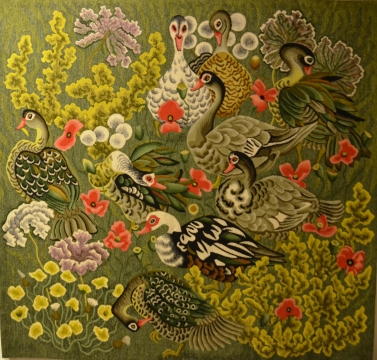Within the framework of the Jacques et Jeaninne Versluys-Evrard Fund, the King Baudouin Foundation has received five contemporary tapestries that illustrate the 20th century revival of tapestry making in France and Belgium. They will be entrusted to the TAMAT, the Centre for Tapestries, Mural Arts and Fabric Arts of the Wallonia-Brussels Federation.
During the 19th century, the art of tapestry making was on the decline in Europe. Lacking creativity, weavers increasingly copied ancient paintings and created very little that was really new. Then, in 1937, the Tabard workshop in Aubusson teamed up with the artist Jean Luçat. Under his impulse and that of other artists, including Saint-Saëns, Dom Robert, Matégot and Calder, tapestry making witnessed a real creative momentum, with large compositions full of colour and geometric shapes. Interiors were barer and walls were broader, so tapestry was quickly adopted as one of the decorative arts and Aubusson once more became the epicentre of tapestry-making in France.
Among the tapestries received as part of the donation is the one entitled "La salamandre" (The Salamander) by Jean Lurçat. Lurçat was a French painter, ceramist and tapestry designer and he was responsible for restoring the prestige of tapestry and for the economic recovery of the workshops by stimulating orders and publicising Aubusson, which led to the creation of new employment.
In the wake of Jean Lurçat, came the tapestry designers Dom Robert and Jean Picart Le Doux who both produced high quality tapestries at Aubusson. The King Baudouin Foundation received "Ciel rouge" (The Red Sky) by Jean Picart Le Doux and "Les Canards de Loul" (The Loul Ducks) by Dom Robert. Robert was a Benedictine monk and produced an exceptional number of fine tapestries. His poetic and colourful style is easily recognised by his subjects, which were inspired by nature.
Finally, two tapestries by the Belgian artist Edmond Dubrunfaut were included in the donation made to the King Baudouin Foundation: "En arrêt" (At a Standstill) and an untitled tapestry. As the initiator of the revival of tapestry-making in Belgium, Dubrunfaut often wove his tapestries in Tournai at the CRECIT (Centre for Research, Trials and Scientific and Technical Control) for the textile industry.
